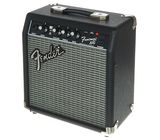The build quality, while not on par with that of its big brother, the Champion 20, is surprisingly good. I have owned an older iteration of this model, back when it was made in Indonesia, and the quality was worse. The unit is lightweight, but, despite having very thin fingers, I am only able to fit three of them under its handle, which makes it uncomfortable to carry the amplifier. It seems that the handle was made narrower in order to preserve the esthetic proportions of the historic design.
The extraneous noise heard upon turning the amplifier on was barely perceptible, which is a pretty rare thing in this price range. After fiddling with the controls for a couple of minutes, I was able to dial in a decent “clean” tone, but no matter what I did, I was unable to completely eliminate the “thinness” of the sound, which could probably be blamed on the small speaker. If my memory serves me right, the Vox Pathfinder 10, which I owned a decade or so ago, sounded a bit “fuller”. But now, back to the Fender. I always play “clean”, so “dirty” tones are not my specialty, but when I tried the built-in overdrive, it sounded to my ears like a jar full of wasps — shrill and irritating. Here, again, the aforementioned Pathfinder 10 excels, but for those who play “clean” or get their “dirty” sounds from a pedal, the Frontman 10G should do just fine.
One of the main selling points for me was the auxiliary input. I think, every practice amplifier should have this underappreciated feature because it enables to practise with a backing track and use the amplifier as a speaker for listening to music.
I have deducted one star from the features category because of the lack of reverb, but I understand that the inclusion of either an analog spring unit or a digital chip would have increased the price of the amplifier, thus putting it out of the reach of some players. But if money is not a problem, I would highly recommend saving up and going for the Champion 20 instead because it really does sound a lot better (I know because I own both, the Frontman 10G and the Champion 20).
To sum up, the Frontman 10G offers a surprisingly good build quality, an excellent portability, and a good, although a little “thin”, “clean” tone. You can also plug in an external device and play music or backing tracks from it. It is worth trying out, but I think that it is better to save up for the Champion 20.

